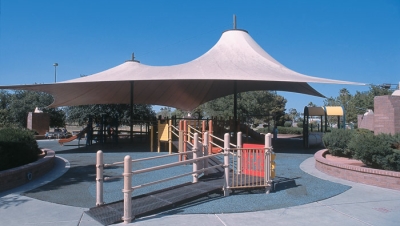I haven't thought of this old adage in years. You know, the one that goes, “If I’ve told you once, I’ve told you a thousand times... ” followed by a mother’s plea to a child to stay off the kitchen counter, put on his safety belt, look before he crosses the street, or go down the slide feet first. And kids, as if prompted by the adventure demon, will still climb on the kitchen counter will always have to be reminded to put on their safety belt, and will try to go down— and up—the slide every which way. Hopefully, they don’t suffer anything more than a bump or a bruise along the way.
To help out with this, the Consumer Product Safety Commission developed the CPSC Handbook for Public Playground Safety, first published in 1981. It was then a two-volume handbook, superseded by a single-volume handbook a decade later. Those who participated in the playground movement during this 10-year period watched the pendulum swing from that of identifying and avoiding extreme and fundamental hazards such as entrapments, entanglements, and lack of safety surfacing, to another extreme—super safe designs that meet CPSC guidelines to the letter of the law, but are just plain boring.
When the pendulum started to swing back in favor of the children— who just want to have fun—it was because engineers and playground designers got creative with their interpretation of the CPSC guidelines and ASTM standards. Playgrounds became original, creative, and fun, and still met guidelines and standards (if not to the letter of the law, at least within the spirit of it). Examples include a 10-foot high enclosed tube slide coming off an even higher deck installed in a large city neighborhood park, some traditional school equipment with a funky space-age feel installed at a local elementary, and of course the newfangled play nets—even ones that spin—as high as the sky but with an interpretation of critical fall heights that even the most finicky risk managers find logical.
Many of the members of the ASTM-F15 Committee have dedicated their professional lives to the evolution of children’s play and playgrounds. They are highly educated people with the skills to put forth a document that will be useful well into the future.
As with all human ventures, personal values and political views come into play. It kind of reminds me of grownups playing in a grownup playground setting. So if you have any inclination to put in a last word for policy changes, for more guidelines to try to keep children from ever getting an ouchy, or if your attitude is just “Let the kids play,” this is your last chance to share your opinion with an ASTM Committee member.
And just for the record, if I’ve told you once, I’ve told you a thousand times, kids will be kids and will continue to play on playgrounds in both appropriate and inappropriate ways. And, grown-ups will continue to make policy based on science, personal values, and hopefully a good measure of common sense.













